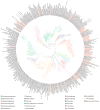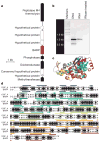A phylogeny-driven genomic encyclopaedia of Bacteria and Archaea
- PMID: 20033048
- PMCID: PMC3073058
- DOI: 10.1038/nature08656
A phylogeny-driven genomic encyclopaedia of Bacteria and Archaea
Abstract
Sequencing of bacterial and archaeal genomes has revolutionized our understanding of the many roles played by microorganisms. There are now nearly 1,000 completed bacterial and archaeal genomes available, most of which were chosen for sequencing on the basis of their physiology. As a result, the perspective provided by the currently available genomes is limited by a highly biased phylogenetic distribution. To explore the value added by choosing microbial genomes for sequencing on the basis of their evolutionary relationships, we have sequenced and analysed the genomes of 56 culturable species of Bacteria and Archaea selected to maximize phylogenetic coverage. Analysis of these genomes demonstrated pronounced benefits (compared to an equivalent set of genomes randomly selected from the existing database) in diverse areas including the reconstruction of phylogenetic history, the discovery of new protein families and biological properties, and the prediction of functions for known genes from other organisms. Our results strongly support the need for systematic 'phylogenomic' efforts to compile a phylogeny-driven 'Genomic Encyclopedia of Bacteria and Archaea' in order to derive maximum knowledge from existing microbial genome data as well as from genome sequences to come.
Figures




Comment in
-
Filling the gaps in the genomic landscape.Genome Biol. 2010;11(2):103. doi: 10.1186/gb-2010-11-2-103. Epub 2010 Feb 16. Genome Biol. 2010. PMID: 20210981 Free PMC article.
Similar articles
-
Distribution of nitrogen fixation and nitrogenase-like sequences amongst microbial genomes.BMC Genomics. 2012 May 3;13:162. doi: 10.1186/1471-2164-13-162. BMC Genomics. 2012. PMID: 22554235 Free PMC article.
-
Genomic encyclopedia of bacteria and archaea: sequencing a myriad of type strains.PLoS Biol. 2014 Aug 5;12(8):e1001920. doi: 10.1371/journal.pbio.1001920. eCollection 2014 Aug. PLoS Biol. 2014. PMID: 25093819 Free PMC article.
-
En route to a genome-based classification of Archaea and Bacteria?Syst Appl Microbiol. 2010 Jun;33(4):175-82. doi: 10.1016/j.syapm.2010.03.003. Epub 2010 Apr 20. Syst Appl Microbiol. 2010. PMID: 20409658 Review.
-
Insights into the phylogeny and coding potential of microbial dark matter.Nature. 2013 Jul 25;499(7459):431-7. doi: 10.1038/nature12352. Epub 2013 Jul 14. Nature. 2013. PMID: 23851394
-
[A system for comparative analysis of microbial genomes].Nihon Rinsho. 2003 Mar;61 Suppl 3:441-8. Nihon Rinsho. 2003. PMID: 12718007 Review. Japanese. No abstract available.
Cited by
-
Physiology, Biochemistry, and Applications of F420- and Fo-Dependent Redox Reactions.Microbiol Mol Biol Rev. 2016 Apr 27;80(2):451-93. doi: 10.1128/MMBR.00070-15. Print 2016 Jun. Microbiol Mol Biol Rev. 2016. PMID: 27122598 Free PMC article. Review.
-
L-form bacteria, cell walls and the origins of life.Open Biol. 2013 Jan 8;3(1):120143. doi: 10.1098/rsob.120143. Open Biol. 2013. PMID: 23303308 Free PMC article. Review.
-
Current opportunities and challenges in microbial metagenome analysis--a bioinformatic perspective.Brief Bioinform. 2012 Nov;13(6):728-42. doi: 10.1093/bib/bbs039. Epub 2012 Sep 9. Brief Bioinform. 2012. PMID: 22966151 Free PMC article. Review.
-
Transcriptome analysis reveals strain-specific and conserved stemness genes in Schmidtea mediterranea.PLoS One. 2012;7(4):e34447. doi: 10.1371/journal.pone.0034447. Epub 2012 Apr 4. PLoS One. 2012. PMID: 22496805 Free PMC article.
-
Genome sequence of the homoacetogenic bacterium Holophaga foetida type strain (TMBS4(T)).Stand Genomic Sci. 2012 May 25;6(2):174-84. doi: 10.4056/sigs.2746047. Epub 2012 May 4. Stand Genomic Sci. 2012. PMID: 22768361 Free PMC article.
References
-
- Eisen JA. Assessing evolutionary relationships among microbes from whole-genome analysis. Curr Opin Microbiol. 2000;3:475–480. - PubMed
Publication types
MeSH terms
Substances
Associated data
- Actions
- Actions
- Actions
- Actions
- Actions
- Actions
- Actions
- Actions
- Actions
- Actions
- Actions
- Actions
Grants and funding
LinkOut - more resources
Full Text Sources
Other Literature Sources
Research Materials

